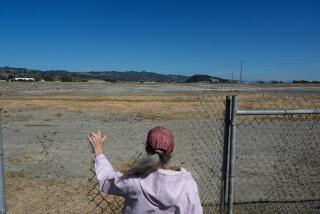Stakes Are High in Nuclear Worker’s Suit : Courts: Former inspector at San Onofre plant says she contracted cancer because of her job. If she wins, other workers might be encouraged to bring similar legal actions.
- Share via
SAN DIEGO — In a worker safety case that could have a major impact on the nation’s nuclear power industry, a former Nuclear Regulatory Commission inspector is suing the operators of the San Onofre nuclear plant on the grounds that she contracted cancer from leaking radiation at the plant.
Rung C. Tang, whose damage suit is set to begin trial next week, says her work at San Onofre left her stricken with acute myelogenous leukemia, a cancer associated with survivors of the Hiroshima and Nagasaki atomic bombs and the Chernobyl nuclear accident.
If Tang wins, it could encourage other suits by other workers against the nation’s 109 nuclear plants, potentially imperiling the financial viability of an industry already beset by economic and political problems, some industry observers say.
Tang, now 44 and hospitalized after a bone marrow transplant, was assigned to San Onofre as an inspector during 1985 and 1986, a period in which the plant had continual problems with defective fuel rods and hundreds of incidents involving so-called fuel fleas.
Fuel fleas are microscopic particles of radioactive material that escape from containment areas of nuclear plants. At San Onofre, particles clung to workers who unknowingly carried them to supposedly safe areas in the plant and to the community outside.
Still, Ned Isokawa, an attorney representing Southern California Edison, the plant’s operator, said he is confident his client will prevail. ‘Our case is based on good science, good medicine and good measurements,” Isokawa said.
Edison has maintained all along that Tang’s exposure to radiation was well below the level set by the Nuclear Regulatory Commission as acceptable. Her suit is the first time a nuclear worker has alleged in court that he or she contracted cancer at the work site.
The suit will allow Tang’s lawyers to present evidence on two points that nuclear critics have long argued: That monitoring devices worn by workers to measure their personal exposure to radiation are unreliable, and that there is no such thing as a safe dose of radiation.
“If we’re successful,” said Tang’s lawyer Don Howarth, of the Los Angeles firm of Howarth & Smith, “we will crack open for the first time the liability of these nuclear power plants for what they’ve been doing to their workers and the communities outside.”
Tang’s suit targets Edison, the plant’s operator and majority owner, as well as San Diego Gas & Electric Co., which owns 20%, and the companies which built the plant--Westinghouse Electric Corp., Combustion Engineering Inc. and Bechtel Corp. The plant is on the coast north of Oceanside, close to the boundary of San Diego and Orange counties.
Edison’s attorneys sought unsuccessfully to have the suit thrown out of court by arguing, in effect, that the federal standards give nuclear power plants immunity from suits like Tang’s as long as the radiation levels set for workers have not been exceeded.
Federal Judge Gordon Thompson Jr. rejected that argument, saying that a nuclear plant is subject to liability laws just like any other business. Although civil suits can often drag on for years, Thompson accelerated the trial date after Tang’s doctor said that her life expectancy is six months.
At an unsuccessful settlement conference this week, Howarth sought to settle his client’s case for $15 million.
Howarth said Isokawa told him that Edison does not want to settle out of court because it could bring a flood of similar cancer lawsuits. Isokawa declined to discuss what was said during the closed-door conference.
“What I think is important is that Ms. Tang’s job as an inspector did not take her into areas where there were fuel fragments hardly at all,” Isokawa said. “Our records show that she spent 95% of her time outside areas where fuel fragments were found.”
Isokawa added that Tang’s exposure, as measured by devices given to her by San Onofre and the NRC, showed only 1/600th of the amount considered permissible by the NRC.
But through the legal process of discovery, Howarth and his partner, Suzelle Smith, have received internal documents from Edison written during 1985-87 in which San Onofre officials candidly discuss the shortcomings and unreliability of the employee badges and other monitoring devices and methods.
In one 1987 document, a San Onofre safety supervisor said that a certain kind of detector will “not be able to detect fuel fragments in the field except for larger particles under very ideal conditions. . . . The slightest covering (e.g. tape glue, cloth fiber) will stop the alpha particles from reaching a detector.”
Tang has been in an isolation unit of a Los Angeles hospital for the past month undergoing radiation therapy, chemotherapy and a bone marrow transplant. “I’m angry because I feel there’s a lot of cover-up (at San Onofre),” she said. “With the company, profits seem to come before safety.”
The San Onofre plant was plagued by defective rods and fuel fleas while Tang was assigned there, but plant officials never ordered a full-scale shutdown to take corrective action. Instead they took such steps as destroying 7,000 protective suits worn by workers in an effort to destroy the fleas.
Later the NRC fined San Onofre $100,000 for safety violations involving fuel fleas and for slowness in reporting the problem. The NRC decision did not involve Tang. In fact, Tang said she never had any idea that she might be in danger at San Onofre.
“The plant is so clean and you think you’re perfectly safe,” said Tang, who left the NRC after seven years in 1986 to join her sister’s insurance business in Pasadena. She was diagnosed with cancer earlier this year.
About 10,000 Americans a year are diagnosed with acute myelogenous leukemia; in all, 1 million new cases of cancer are diagnosed annually in this country. Myelogenous leukemia attacks the bones and then spreads to other organs, and, in cases where radiation is thought to be the cause, can strike up to 15 years after exposure.
Dr. Cary Presant, president of the California branch of the American Cancer Society, said that although myelogenous leukemia can be caused by radiation, most people with the disease have had no known exposure to radiation other than that present in nature.
This leads scientists to conclude that there are other causes as yet undiscovered, said Presant, who is not involved in the Tang suit. Presant also said this type of cancer has a 50% cure rate.
Edison’s attorney, Isokawa, suggested that Tang will not be able to prove that radiation from San Onofre, rather than some other cause, triggered her illness.
But Dr. Harry B. Demopoulos, a radiology expert and associate medical professor at New York University, has provided an affidavit for Tang’s attorneys asserting that “a substantial factor” causing Tang’s leukemia was her exposure to radioactive material at San Onofre.
Demopoulos added that San Onofre’s slow and limited response to the problem of uncontrolled radiation spreading through the plant violated “general principles of acceptable public health procedures, as well as NRC published mandates and guidelines.”
Isokawa promised to present medical and nuclear safety experts who will contradict Demopoulos. He said the fact that Tang’s suit is the first by a nuclear worker diagnosed with cancer is a testament to the industry’s “very conservative standards and stringent controls” in protecting workers.
Tang’s attorneys, Howarth and Smith, countered that there have been no other suits like Tang’s because most workers are covered by workers’ compensation plans and thus not allowed to sue for medical problems or liability.
Robert Pollard, a former NRC employee now affiliated with the anti-nuclear Union of Concerned Scientists, said the Tang suit could have a “tremendous impact” on the nuclear industry because it would force it to add further safeguards and employees.
“It would be another severe blow to the already deteriorating economic circumstance of the industry,” said Pollard.
Scott Peters, spokesman for the U.S. Council for Energy Awareness, a nuclear industry trade group, said, “I assume (if Tang wins), others will try the same thing.”
Tang said she filed suit to provide money for her daughter, Elizabeth, 21, a senior at the Massachusetts Institute of Technology. Tang, who immigrated from Taiwan and lives in Pasadena, received a master’s degree in nuclear engineering from MIT in 1978.
Tang said her daughter had also been studying nuclear engineering but Tang talked her into switching majors. “I didn’t want to do it, but I didn’t think it was safe,” she said.
More to Read
Sign up for Essential California
The most important California stories and recommendations in your inbox every morning.
You may occasionally receive promotional content from the Los Angeles Times.










